Nature Trail
Felines: small, wild and beautiful - V:
Vulnerable threesome
Are you surprised that there are so many beautiful relatives of your
lovable pet cat living in the wild? Out of the eight wild cats we have
featured so far, which cat do you think has the most beautiful fur coat?
Do you know that many of these innocent cats are hunted by humans simply
for their fur coats. It is not as if humans cannot survive without the
fur coats of these wild creatures. So, why destroy them to satisfy just
a fancy we have.
We must learn to respect and protect our friends in the wild just as
much as we do the animals we rear at home. If you have friends or family
members who hunt down our 'dumb friends' for sport, make an attempt to
discourage them.
Meanwhile, let's check out three more wild beauties this week. They
too are as fascinating as the other members of the cat family we've
featured before. These three cats are vulnerable of becoming extinct not
only because two of them are rare, but because they are being hunted and
their habitats are being destroyed.
Bay cat
The bay cat, (Catopuma badia) or the Bornean bay cat as its popularly
known is an elusive member of the cat family endemic to the Island of
Borneo. It is also known as the Bornean red cat in some areas. It is the
least known and studied species of all wild cats and in fact, until 1998
no one had been able to capture this cat even on camera.
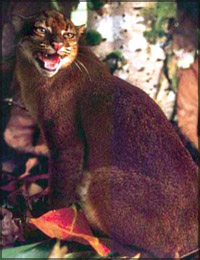 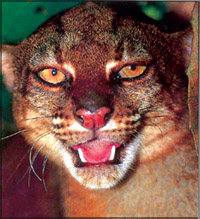 The
first picture of the bay cat, the rarest cat species in the world, had
been taken by a BBC photographer and published only in 1988. Researchers
once believed that the bay cat was related to the Asian gold cat, but
after much studies, it was later concluded that the two cats belonged to
two different species. The
first picture of the bay cat, the rarest cat species in the world, had
been taken by a BBC photographer and published only in 1988. Researchers
once believed that the bay cat was related to the Asian gold cat, but
after much studies, it was later concluded that the two cats belonged to
two different species.
This decision had been made after analysing the skull structures of
the two cats. The bay cat is generally the size of a house cat with an
extra long tail. It is about 55 cm (22 inches) in length with a tail of
35 cm (14 inches). The cat weighs around 2.3 to 4.5 kg (5-10 lbs). The
cat's base coat colouration can be grouped into two types; common
reddish brown and bluish or blackish grey.
The back and flanks are generally covered with the base coloured fur
while the underside is paler. The ears are short and rounded and set
well down on the sides of the head. The head too is more rounded than in
other cats. It has two dark prominent stripes running from the corner of
each eye and a marking in the shape of the letter M at the back of the
head. The bay cat is found in altitudes of 900 metres in dense rain
forests, rocky outcrops and highland areas. It is found even in swamps
at times.
Like all the other cats, the bay cat too feeds on small monkeys,
rodents, reptiles, insects and birds. It hunts mostly in the night. This
mystery cat of the forest is considered vulnerable. It is under threat
because of habitat loss and needs to be protected from becoming extinct.
Asian golden cat
Striking in appearance, the Asian golden cat (Catopuma temmincki)
also referred to as Temmincki's golden cat is found in South East Asia,
including the Malay Peninsula and Sumatra. It shares many common
features with the golden cat found in East and Central Africa. However,
it is considered to be a separate species.
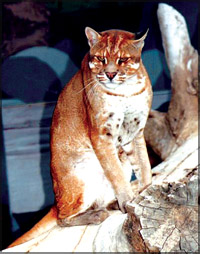 The
Asian golden cat's habitat is generally dense tropical and sub tropical
forests. It is found in the southern edge of the Himalayas in altitudes
up to 10,000 ft. Three sub species of this elusive predator, which
features prominently in Asian folk lore, have been identified. The
Asian golden cat's habitat is generally dense tropical and sub tropical
forests. It is found in the southern edge of the Himalayas in altitudes
up to 10,000 ft. Three sub species of this elusive predator, which
features prominently in Asian folk lore, have been identified.
According to one legend, a single hair of the Asian golden cat has
the power to protect the bearer from the fierce tigers.
This medium sized wild cat, about 90 cm (36 inc) long with a tail of
around 50 cm (20 inc), weighs between 12-16 kgs (26-36 lbs). It prefers
to hunt its prey on the ground, but is capable of climbing trees when
necessary.
It usually stalks its prey and then rushes into attack, like most
wild cats typically do when it comes to hunting techniques. What is
unusual is that this particular species is known to hunt in pairs.
Its markings and base colouration varies from one region to another.
Some have a golden brown or foxy red base colour while others are
melanistic or all black in colours.
Commonly it has one colour without markings except for faint spots on
its under parts. White line markings run up across head, cheeks and
corner of eyes.
In China, the Asian golden cat's markings appear more like that of a
leopard's. Its pelt is of a moderate length, dense and rather hard.
A nocturnal creature, the Asian golden cat's diet includes small to
medium sized mammals, rabbits, deer, sheep and even goat.
The female gives birth to a litter of 1-3 kittens after a gestation
period of 80 days. The young weigh around 250g at birth. The kittens
open their eyes after nine days and are able to walk by the time they
are 17 days old. The females mature at 18 months and the males by the
time they are two years old. Males are believed to play quite an active
role in the rearing of the young.
In captivity it is said to be rather docile and tranquil, but in the
wild, it is considered to be fierce. It can live up to 20 years in
captivity.
The Asian golden cat which is the size of a large dog, is also under
threat like most of the other wild cats in the family.
Marbled cat
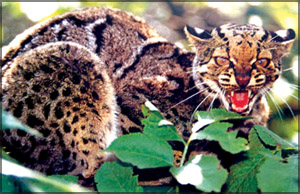 Similar
to the domestic cat, but with a longer, thicker and more furry tail, the
marbled cat (Pardofelis marmorata) is found from Assam in northern India
through southeast Asia including Borneo and Sumatra. Similar
to the domestic cat, but with a longer, thicker and more furry tail, the
marbled cat (Pardofelis marmorata) is found from Assam in northern India
through southeast Asia including Borneo and Sumatra.
Primarily an animal of moist, tropical forests, the marbled cat is
even found in mixed deciduous, evergreen forest areas, mountainous
evergreen forests and secondary forests from sea level to about 3000 mts
(10,000 feet) above sea level.
It is another member of the cat family, like the bay cat, which is
believed to be rare. In China it is known as the small clouded leopard
because of the similarity in the markings of its coat.
However, unlike in the clouded leopard's coat, the black-edged
blotches on the marbled cat's coat are less distinctive.
Even the black spots on the legs are more in number. In size too, the
marbled cat is much smaller and is less than one third of the weight of
the clouded leopard. It is 4.5 kg (10 lbs) in weight and 53 cm (21 inc)
in length with a tail of 45 cm (18 inches).
Solitary and elusive, the marbled cat is mainly arboreal. It depends
mostly on the tree top canopy for shelter and food which includes birds,
squirrels, rodents and reptiles.
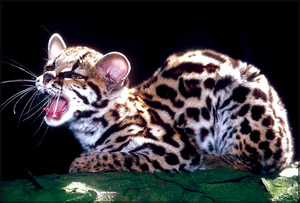 The
base fur colouration of the marbled cat's coat varies from pale yellow
to brownish-grey with a lighter underside. The coat is extremely thick,
but soft. The legs and underside are marked with black dots. The tail
which is black tipped is covered with black spots and rings. The
base fur colouration of the marbled cat's coat varies from pale yellow
to brownish-grey with a lighter underside. The coat is extremely thick,
but soft. The legs and underside are marked with black dots. The tail
which is black tipped is covered with black spots and rings.
There are stripes on the neck and irregular stripes on the back. It
sports well defined line stripes on its face extending from the corner
of each eye and joining over the forehead.
After a gestation period of 80-82 days, the female gives birth to a
litter of 1-4 kittens. It has a 8-10 year life span. The marbles cat is
protected in India and Thailand. Breeding is not very successful in
zoos. In fact, they are seldom kept in captivity. |
